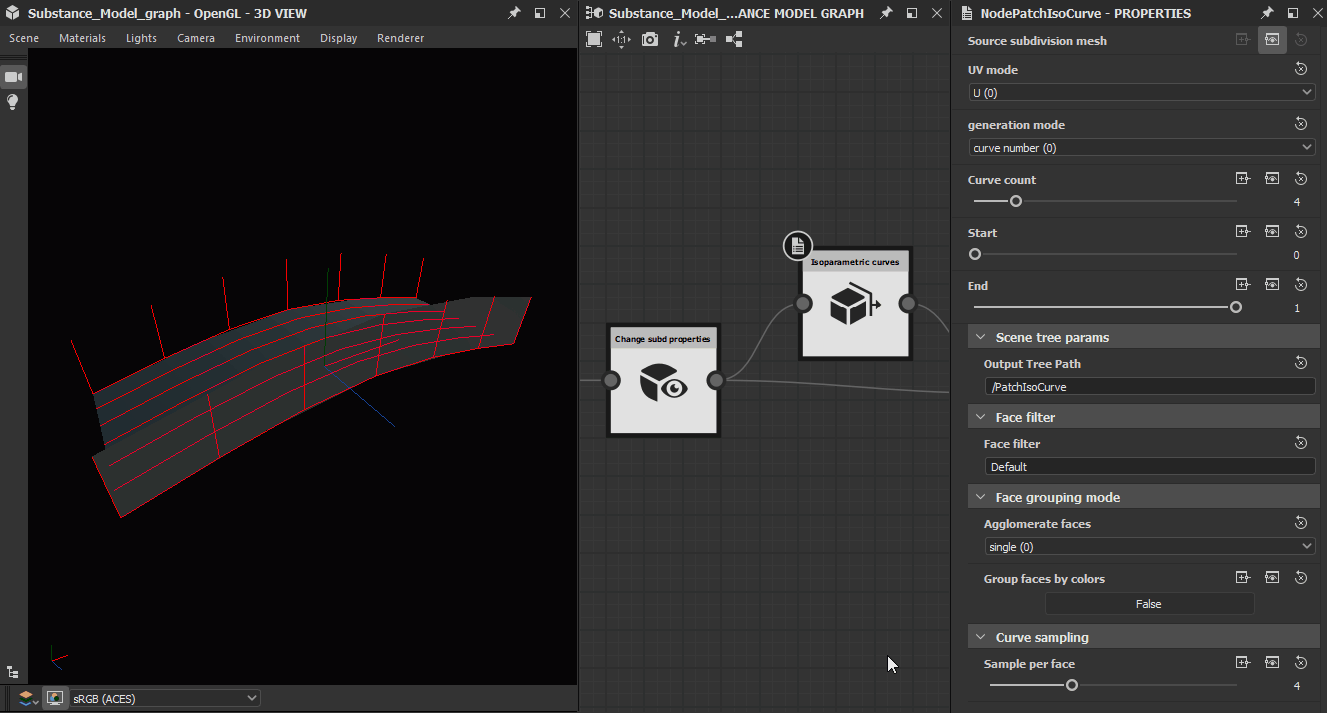Isoparametric curves


In: Substance Model graph/Extraction
Intermediate
Description
The Isoparametric curves node extracts Curves from the faces of the control mesh for a SubD mesh, using the specified face grouping method. For smooth SubD meshes, extracted Curves follow the shape of the smoothed faces as the number of samples per face increases.
For a given face with U,V coordinates from 0 to 1, an isoparametric curve is the result of all points across the surface where one coordinate varies from 0 to 1 while the other stays the same – all points use that same coordinate or parameter, hence the term isoparametric.
Parameters
Scene parameters
- Output scene path String
Sets the Item name and possibly its containing groups. Learn more in the Path expressions and filtering section
- Output scene path String
- Source subdivision mesh Scene
The input Scene holding the SubD meshes which Curves should be extracted from Face filter
- Face filter String
The name – or tag – of the selection set for the faces which should be sampled for Curve extraction. The Default value means all faces are sampled
Note: Only some 3D packages let you tag selection sets. For instance, Autodesk Maya, Autodesk 3ds Max and The Foundry's Modo support this feature
- Face filter String
Face grouping mode
- Agglomerate faces Integer
The method used to agglomerate faces into groups to simplify the generation of Curves into fewer ones which cover a wider span of the control mesh. The following methods are available:- single: Faces are not grouped together
- row: adjacent faces along an axis determined by the UV mode parameter are grouped together in stripes. Parellel stripes are not grouped together
- rectangle: adjacent faces along an axis determined by the UV mode parameter are grouped together in stripes. Parellel stripes are grouped together
- Group faces by colors Boolean
Controls whether faces with matching vertex colors should be grouped together. This grouping compounds the grouping method selected in the Agglomerate faces parameter
- Agglomerate faces Integer
Curve sampling
- Sample per face Integer
The number of samples performed on individual edges. A higher value means a more accurate representation of the smoothed subdivided edge and thus a smoother path – if the SubD mesh is not infinitely sharp.
- Sample per face Integer
- UV mode Integer
The method used to determine the varying parameter and the fixed parameter when sampling points across a face, from the following options:- U: the U coordinate stays the same when sampling points
- V: the V coordinate stays the same when sampling points
- Mostly along: the coordinate which stays the same is defined relatively to the axis specified in the Chosen Axis parameter
- Mostly orthogonal to: the coordinate which stays the same is defined relatively to the axis which is orthogonal (i.e. perpendicular) to the one specified in the Chosen Axis parameter
Area orientation
- Chosen axis Integer
Lets you change the orientation of the axis that Curves are generated along or orthogonally to
Note: this parameter is only available when the UV mode parameter is set to Mostly along or Mostly orthogonal to
- Chosen axis Integer
- Generation mode Integer
The method used to determine how many curves are generated and how they are spaced, from the following options:- curve number: lets you specify the number of curves which should be placed across a face, with equal spacing
- spacing: lets you specify the amount of spacing between curves. The number and placement of curves is automatically adjusted so equal spacing is maintained while the first and last curves are placed on opposite ends of the face
- Curve count Integer
The number of curves which should be generated on each face
Note: This parameter is only available when the Generation mode parameter is set to curve number - At Float
The position of the Curve on the face – i.e. the value of the varying parameter
Note: This parameter is only available when the Generation mode parameter is set to curve number and its value is 1 - Start Float
Applies an offset to the starting point of the face for generating Curves. This impacts both curve number and spacing generation methods
Note: This parameter is only available when the Generation mode parameter is set to curve number and its value is higher than 1 - End Float
Applies an offset to the ending point of the face for generating Curves. This impacts both curve number and spacing generation methods
Note: This parameter is only available when the Generation mode parameter is set to curve number and its value is higher than 1 - Curve spacing Float
The amount of spacing between each curve. This amount is automatically adjusted in the background so equal spacing is maintained while the first and last curves are placed on opposite ends of the face
Note: This parameter is only available when the Generation mode parameter is set to spacing - Padding in Float
Applies an offset to the starting point of the face for generating Curves. This impacts both curve number and spacing generation methods
Note: This parameter is only available when the Generation mode parameter is set to spacing - Padding out Float
Applies an offset to the ending point of the face for generating Curves. This impacts both curve number and spacing generation methods
Note: This parameter is only available when the Generation mode parameter is set to spacing
Example Images



